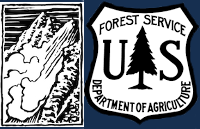24-25
Sluffing new snow
We traversed the ridge south from the Bridger Bowl ski area boundary to Bridger Peak, descended a NE aspect and skinned/traversed back to the ski area boundary. Moderate west winds weren't transporting a significant amount of snow (much of the west side of the ridge was already scoured bare and the remaining snow was already hardened). The sun and clouds were in and out through the day and there were even a few snow flurries, but no accumulation.
Wind Slab avalanches were our primary concern today, but we did not see any as we traversed the ridge and the new snow we encountered was not cohesive.
Dry Loose avalanches (sluffs) ended up being the biggest hazard we encountered. The new snow (approximately 8") was easily sluffing over last weeks crust and was entraining significant volume and running far in steep terrain. It had plenty of power to knock you over or into trees/rocks.
We saw no slab avalanches or signs of instability.
Wind Slabs in Frazier Basin
Winds in the Frazier Basin zone were stronger than expected with moderate to strong gusts at the ridge, increasing through the day.
Light flurries <S1 through the morning increasing to S1 by the time of our exit. Tough to gauge accumulation due to the wind but would guess 2-3cm total through the day. New snow from yesterday and today is generally not well bonded to the underlying surfaces which range from windboard, supportable crusts, and old wind slabs depending on aspect/wind exposure, and this made for challenging uphill travel at times.
We noticed two large windslab pockets that had released since yesterday’s snow. One at the base of Hardscrabble Peak on a N aspect, the other in one of the SE facing gullies that access the Peak 9299/Hollywood Headwall ridge (see photo).
Stability tests continually fractured on old, broken snowflakes just under a crust under the new snow about 16" deep
Small natural storm slab
This avalanche started on a slope above the rocks where there was more wind and then triggered another storm slab in the trees. It created a significant debris pile.
Forecast link: GNFAC Avalanche Forecast for Sun Mar 16, 2025
Light red lines indicate crown faces of this natural avalanche. It likely started as a wind slab/storm slab above the rocks, then dropped down onto the slope below triggering a storm slab avalanche that entrained a significant amount of snow and created a big debris pile.
Forecast link: GNFAC Avalanche Forecast for Sun Mar 16, 2025
Island Park
We rode to the top of Sawtelle to de-rime the anemometer (wind sensor) and then down into Rock Creek Basin under all the big north facing avalanche paths.
Key findings:
- New snow amounts ranged from 6-8" at lower elevations and 18" at higher elevations
- We did not observe any cracking or collapsing on non wind loaded slopes.
- We observed two very recent natural storm slab avalanches about a 1.5 feet deep. One of them entrained a significant amount of snow an ran a long ways.
- There has been minimal wind effect except at ridgetops
- Extended Column tests on north facing slopes continuously broke and propagated after 12 taps (ECTP12) just under a soft crust in snow that fell last weekend. These appeared to be breaking on broken stellars/snowflakes. On other aspects, the crust was much thicker and harder.
Conclusions:
The likelihood of triggering a soft slab avalanche about 1.5' deep seemed low on non-wind loaded slopes. Any amount of wind affecting a slope whether loading a slope or just stiffening the new snow, dramatically increased the odds of triggering a slide. We felt comfortable riding in avalanche runout zones and even climbing into the paths some. The main strategy was to stay out of the upper starting zones that are steeper and have seen some wind. HOWEVER - we carefully limited our exposure in big runout zones where a falling cornice could have triggered a slide that could have crashed down onto us. We did not think that we would trigger an avalanche from below
Looking ahead - Strong winds Sunday through Monday will have plenty of snow to transport along with additional snow that will fall. This should increase the danger and the size of possible avalanches.
